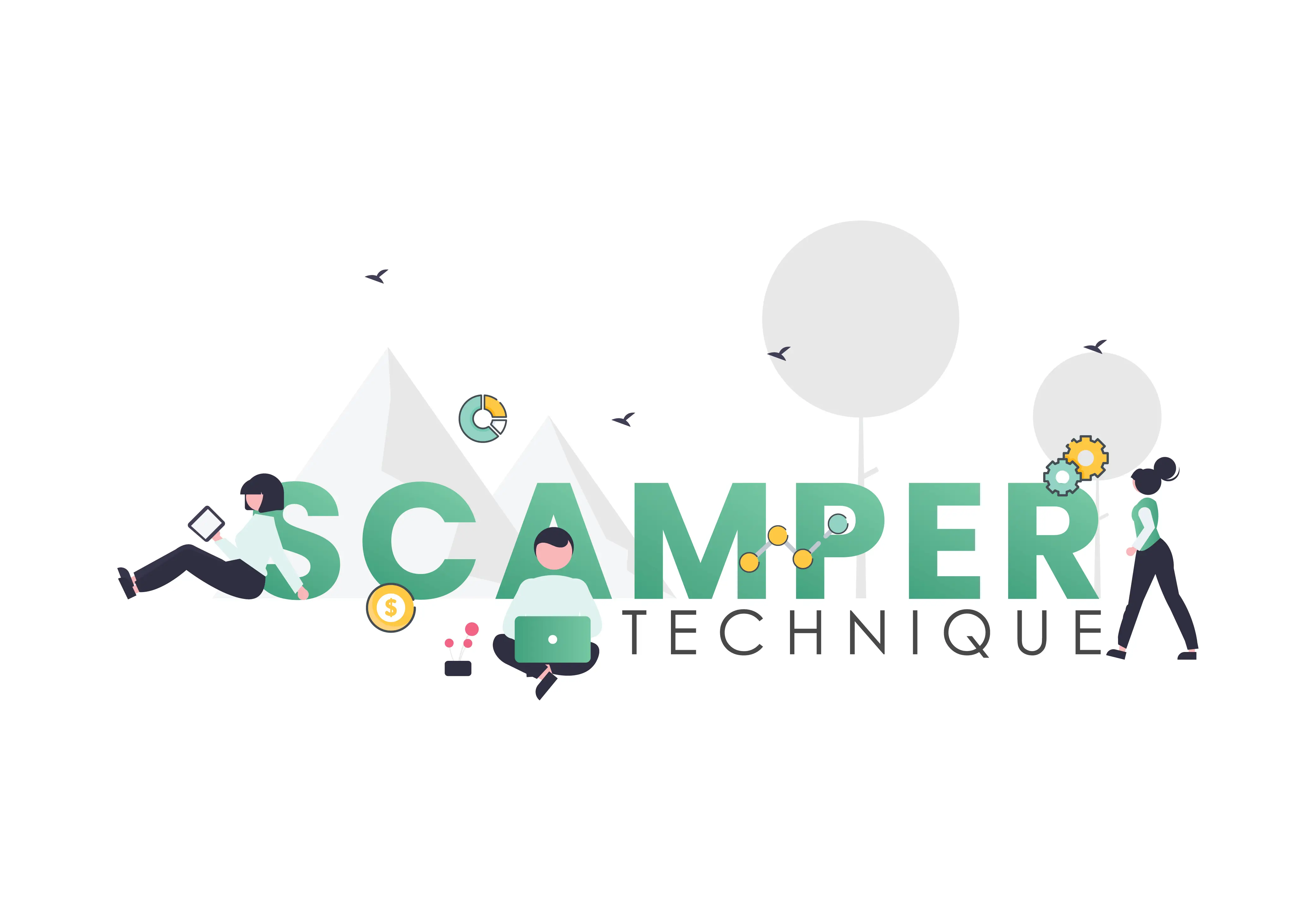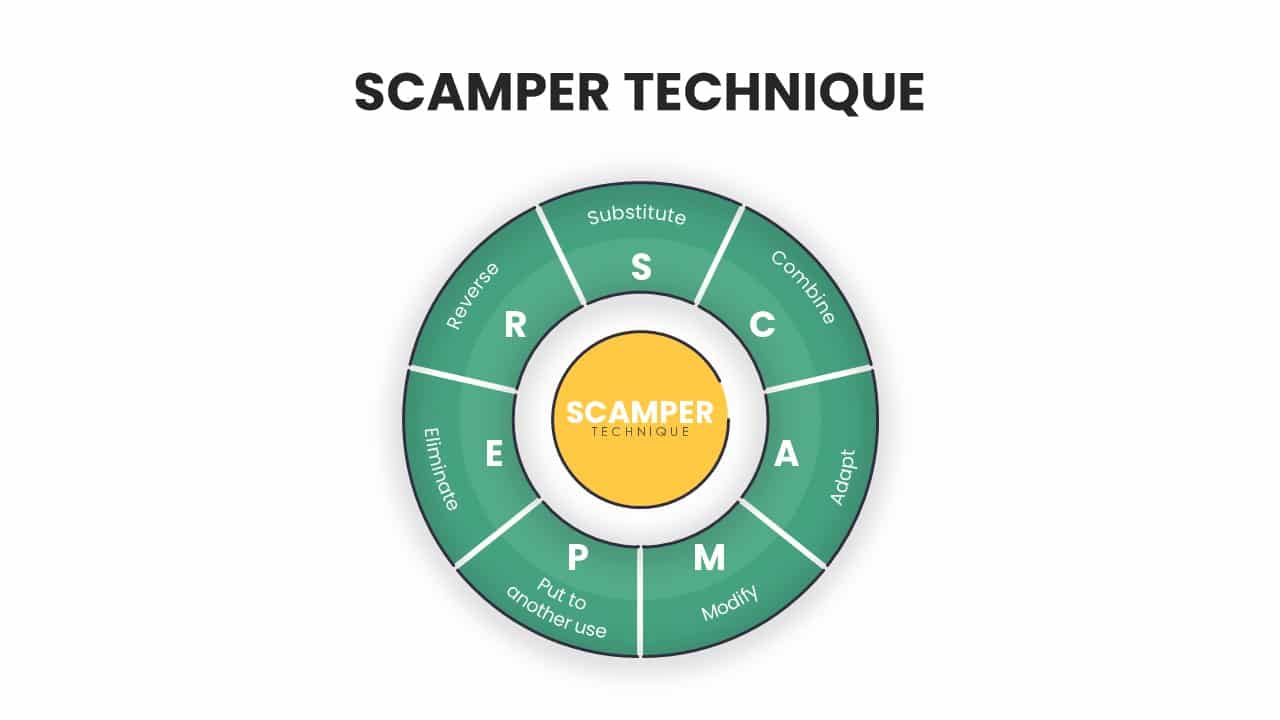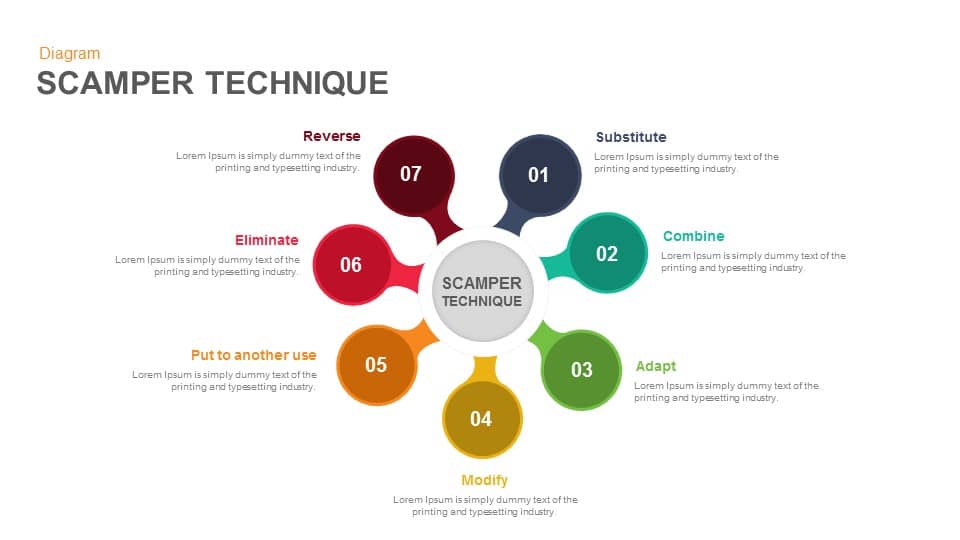Scamper technique : A handbook for design thinkers

Business success depends on creative thinking. Creative thinking and problem-solving have great significance in the design process to turn ideas into innovation and break the obstacles against creativity. Innovation not only means invention but also refers to improving the existing process by adding new ideas that have been never applied in the industry.
One of the successful techniques used in innovative thinking is the SCAMPER technique. At its core SCAMPER is an easy to implement creative thinking and problem-solving method that eases continuous improvement. Instead of creating something entirely new, innovation suggests remodelling existing mechanisms with proper modifications and value additions.
SCAMPER is considered one of the simple and most influential methods. The SCAMPER technique is based very simply on the idea that what is new is in fact an alteration of existing old things around us. Nothing can create from the vacuum.
All existing things are derived as a modified unit of existing materials. Even the thought of yours is not really yours. You have got it from your ancestors and made a modified version. Similarly, each and every material and non-material thing and culture is the product of a prolonged historical evolution. So, SCAMPER is a framework that shows the innovation in existing process or designs will lead to something new.
What is SCAMPER?
SCAMPER is an acronym for Seven Techniques – substitute, combine, adapt, modify, put to another use, eliminate and reverse. So SCAMPER is a group of these many techniques and you can choose to use one or all of the seven methods to find solutions to your problems. These keywords signify the essential questions addressed during the creative thinking meeting.
The SCAMPER technique is very analogous to Design Thinking in that both these concepts aim to find solutions to problems. However, Design Thinking places the human factor at the nucleus and its goal is to find inventive ways to solve problems. The SCAMPER method is more focused on the process of finding strange and creative solutions to problems, but also to come up with advanced ideas, and the goal of improving a product/service.
The scamper technique doesn’t insist you create a sequential flow using the 7 techniques. In other words, you can use any of the techniques from this collection that have seemed more suitable for your problem-solving. So, this is not a step by step method, you can pick one technique by jumping over and implement it to solve your problems. The seven SCAMPER techniques include the following:

Substitute
Substitution is the process of replacing something with another thing. It is all about replacing something, instead of the default. Find a part of your idea, product, service or process etc. that you could substitute with another to see whether it will result in improvements, such as efficiency gains. You can analyze your problem areas while creating questions such as:
- Who or what can be substituted without affecting the process?
- What can be used as an alternative to the product?
- What part of the process can be replaced with better alternatives?
- Can the project time or place be replaced?
- What will happen when we substitute part of the product with another?
- Where else could you sell the product?
- Can we replace the existing device with another better one?
Combine
“Combine” is a technique of integrating unrelated ideas to create something innovative. It is the merging of two ideas and gets a synthesis of new. In some circumstances, merging two innovative ideas can lead to a new product or technology which leads to market strength. This technique can include the following questions:
- How can I join two or more parts of my product to create a different product?
- What mediums can be combined?
- Can we apply two processes at the same time?
- Can I blend two or more components together?
- Do the blending components actually compatible with each other
Adapt
Adaption is one of the efficient techniques to solve problems through enhancing the existing system. It is the way of adapting novel ideas that others have used successfully. By using other’s successful idea you can create a new output that will win over the matches. The adaptation method can include the following questions:
- What can I adapt as a solution?
- What could I copy?
- How can I get it?
- What would I need to change to reach better results?

Download and explain idea with scamper PowerPoint template
Modify/Magnify
Here we are using “Bigger is the best”. This will help you identify which part of your process or concept is the most significant. This change is more than just an adjustment as it emphasises on the whole process. This pick can include the questions such as:
- What can I adjust or put more or less emphasis on in my product, service or process?
- Can I amend the product or service, and its meaning, colour, wrapper, shape etc.?
- Can we modify the Ownership of the product?
- Can we modify the purpose of the product?
Put to other uses
This is very analogous to “Adapt”, it’s about putting a contemporary idea or concept to another use, i.e. using it differently than it was originally intended to. This method can be used to learn how to shift an existing product to another market segment or user type. The questions in this method can include:
- How can I put the thing to other uses?
- What are the benefits of the product if used in a different place?
- What if we target market segmentation for the existing product?
Eliminate
As the name suggests, this method aims to detect the parts of the process that can be eliminated to improve the process product or service. It also helps to identify the unnecessary parts of the product. This is more familiar to those six sigma or lean manufacturing. Questions related to this part include:
- What can I remove from my product or service?
- What would happen if I removed this part?
- What are the benefits while removing unnecessary parts?
Reverse
How could the Schedule be rearranged? This technique aims to find out the original potential when changing the order to the process in the production line. The questions in this part include:
- Can I exchange elements, design or products?
- What would happen if we reverse the process?
- How can we reorder the current status for better output?
The scamper technique helps you to generate an idea for problem-solving. This flexible and easy understanding method helps to reach the best decision and create better problem-solving for your business and professional life as well.
